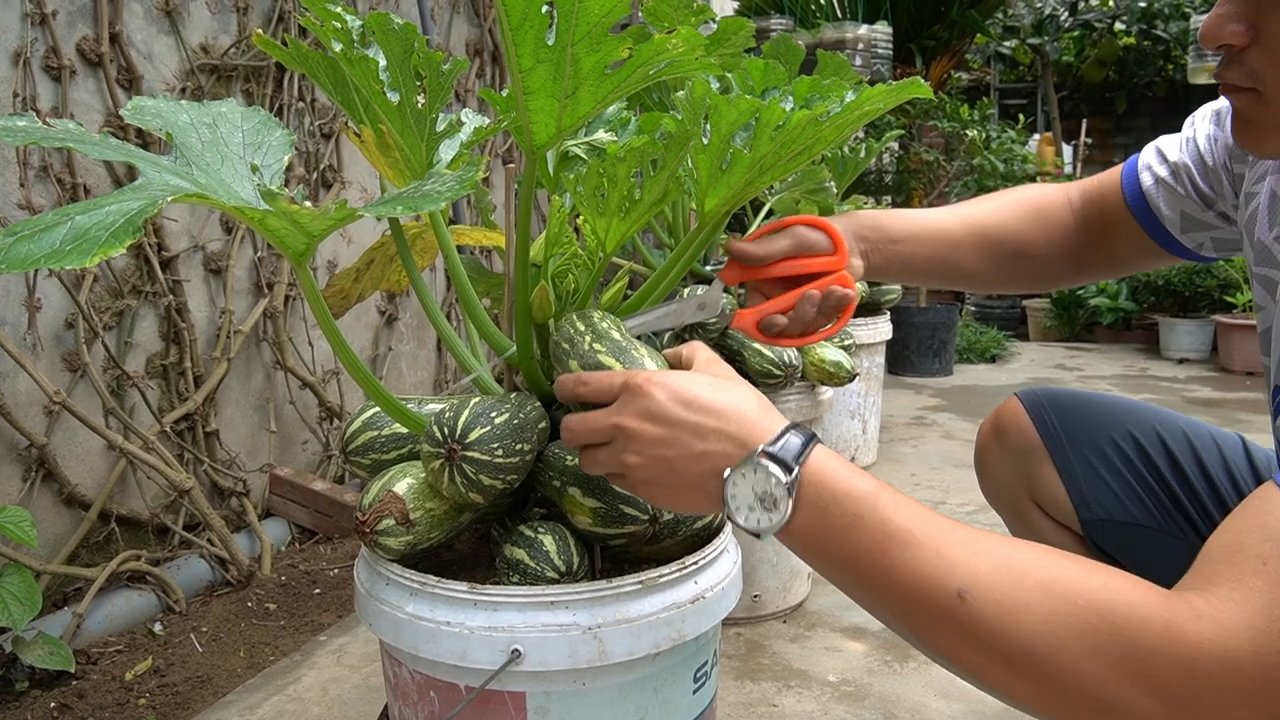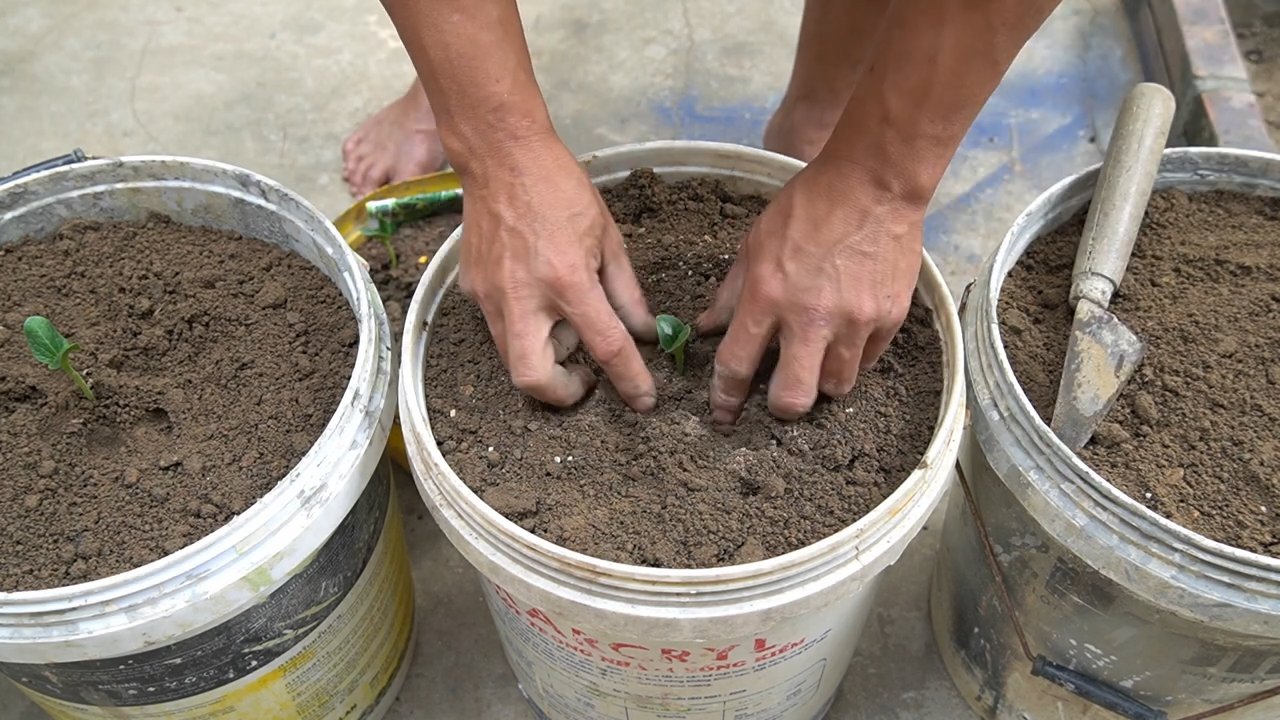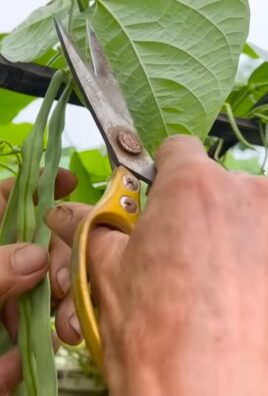Growing zucchini in containers might sound intimidating, but trust me, it’s easier than you think! Have you ever dreamt of stepping outside your door and harvesting fresh, vibrant zucchini right from your patio? Imagine the delicious zucchini bread, grilled zucchini skewers, or even zucchini noodles you could whip up with your homegrown bounty. This isn’t just a gardening trend; it’s a way to connect with nature, enjoy fresh produce, and even save money – all within the cozy confines of your own home.
For centuries, humans have cultivated food in limited spaces. From the hanging gardens of Babylon to the modern-day balcony gardens in bustling cities, the desire to nurture and grow our own food is deeply ingrained in our history. Today, with smaller living spaces and a growing awareness of the benefits of fresh, locally sourced food, container gardening is experiencing a major resurgence.
But why growing zucchini in containers specifically? Well, zucchini is a prolific producer, meaning you get a lot of bang for your buck (or rather, your seed!). Plus, it’s relatively easy to care for, making it perfect for beginner gardeners. Many people struggle with limited garden space, poor soil conditions, or even just the time commitment of a traditional garden. That’s where this DIY guide comes in! I’m going to share my favorite tips and tricks for successfully growing zucchini in containers, so you can enjoy a bountiful harvest, no matter your space or experience level. Get ready to transform your patio, balcony, or even a sunny windowsill into a zucchini paradise!

Growing Zucchini in Containers: A Comprehensive Guide
Hey there, fellow gardening enthusiasts! So, you’re thinking about growing zucchini in containers? Awesome! I’m here to tell you it’s totally doable, even if you don’t have a sprawling backyard. I’ve had great success growing these prolific veggies in pots, and I’m excited to share my secrets with you. Get ready for a summer filled with delicious zucchini bread, grilled zucchini, and maybe even a few zucchini boats!
Choosing the Right Container and Variety
First things first, let’s talk about the essentials: the container and the zucchini variety. This is crucial for success, so pay close attention!
* **Container Size:** Zucchini plants are surprisingly large and need plenty of room for their roots to spread. I recommend a container that’s at least 24 inches in diameter and 24 inches deep. Bigger is always better! Think large pots, half whiskey barrels, or even large grow bags.
* **Drainage:** Excellent drainage is non-negotiable. Zucchini hates soggy roots. Make sure your container has plenty of drainage holes. If not, you can drill some yourself.
* **Material:** The material of the container is less important than size and drainage, but consider the climate you live in. Dark-colored containers can heat up quickly in hot climates, potentially stressing the plant. Lighter-colored containers or terracotta are good options in warmer areas.
* **Zucchini Variety:** Not all zucchini varieties are created equal when it comes to container gardening. Bush varieties are generally more compact and better suited for pots than vining varieties. Here are a few of my favorites:
* ‘Black Beauty’: A classic, reliable producer with dark green fruit.
* ‘Spacemiser’: As the name suggests, this variety is bred for smaller spaces.
* ‘Bush Baby’: A very compact variety, perfect for smaller containers.
* ‘Eight Ball’: Produces round, ball-shaped zucchini, which are fun and easy to manage.
Preparing the Soil and Planting
Now that you’ve got your container and zucchini variety sorted, let’s get our hands dirty!
1. **Choose a High-Quality Potting Mix:** Don’t skimp on the soil! Use a well-draining potting mix specifically formulated for containers. Avoid using garden soil, as it can compact in containers and hinder drainage. I like to mix in some compost for added nutrients.
2. **Fill the Container:** Fill your container almost to the top with the potting mix, leaving a few inches of space at the top.
3. **Planting the Seed or Seedling:**
* **From Seed:** Sow seeds directly into the container about 1 inch deep. Plant 2-3 seeds per container and thin to the strongest seedling once they emerge.
* **From Seedling:** Gently remove the seedling from its nursery pot and loosen the roots slightly. Dig a hole in the potting mix large enough to accommodate the root ball. Place the seedling in the hole and backfill with potting mix, gently firming the soil around the base of the plant.
4. **Water Thoroughly:** After planting, water the container thoroughly until water drains out of the drainage holes. This helps settle the soil and ensures the roots get a good start.
5. **Choose a Sunny Location:** Zucchini needs at least 6-8 hours of sunlight per day to thrive. Place your container in a sunny spot in your yard or on your patio.
Caring for Your Zucchini Plant
Okay, your zucchini is planted, and now the real work begins (just kidding, it’s pretty easy!). Here’s how to keep your plant happy and productive:
1. **Watering:** Zucchini plants are thirsty! Water deeply whenever the top inch of soil feels dry to the touch. During hot weather, you may need to water daily. Avoid overhead watering, as this can lead to fungal diseases. Instead, water at the base of the plant.
2. **Fertilizing:** Zucchini are heavy feeders, meaning they need a lot of nutrients. Fertilize every 2-3 weeks with a balanced liquid fertilizer, following the instructions on the label. You can also use a slow-release fertilizer at planting time.
3. **Mulching:** Add a layer of mulch around the base of the plant to help retain moisture, suppress weeds, and regulate soil temperature. Straw, wood chips, or shredded bark are all good options.
4. **Pest and Disease Control:** Keep an eye out for common zucchini pests like squash bugs, squash vine borers, and aphids. Inspect your plants regularly and take action promptly if you spot any problems. Insecticidal soap or neem oil can be effective for controlling many pests. Powdery mildew is a common fungal disease that can affect zucchini plants. To prevent it, ensure good air circulation around the plant and avoid overhead watering. If you see signs of powdery mildew, treat with a fungicide labeled for use on vegetables.
5. **Pollination:** Zucchini plants have separate male and female flowers. Bees and other pollinators are essential for transferring pollen from the male flowers to the female flowers, which results in fruit production. If you’re not seeing many bees in your garden, you may need to hand-pollinate your zucchini flowers. To do this, use a small paintbrush to collect pollen from the male flower and transfer it to the female flower. The female flowers have a small zucchini fruit at the base, while the male flowers do not.
Harvesting Your Zucchini
The best part! Harvesting zucchini is super rewarding, and you’ll be amazed at how quickly these plants produce.
1. **Harvesting Time:** Zucchini is best harvested when it’s young and tender, typically when it’s about 6-8 inches long. Larger zucchini can become tough and seedy.
2. **How to Harvest:** Use a sharp knife or pruning shears to cut the zucchini from the plant, leaving a short stem attached. Be careful not to damage the plant.
3. **Regular Harvesting:** Harvest zucchini regularly to encourage the plant to produce more fruit. If you let the zucchini get too large, the plant will stop producing.
4. **Enjoy Your Harvest:** Zucchini is incredibly versatile and can be used in a variety of dishes. Grill it, sauté it, bake it into bread, or add it to soups and stews. The possibilities are endless!
Troubleshooting Common Problems
Even with the best care, you might encounter a few challenges along the way. Here are some common problems and how to address them:
* **Yellowing Leaves:** This can be caused by a variety of factors, including overwatering, underwatering, nutrient deficiencies, or pests. Check the soil moisture and adjust your watering accordingly. Fertilize with a balanced fertilizer to address nutrient deficiencies. Inspect the plant for pests and treat as needed.
* **Blossom End Rot:** This is a condition where the blossom end of the zucchini fruit turns brown and rotten. It’s usually caused by calcium deficiency or inconsistent watering. Ensure consistent watering and add calcium to the soil by amending with bone meal or using a calcium-rich fertilizer.
* **Lack of Fruit Production:** This can be caused by poor pollination, lack of sunlight, or nutrient deficiencies. Ensure your plant is getting enough sunlight and consider hand-pollinating the flowers if you’re not seeing many bees. Fertilize with a balanced fertilizer to address nutrient deficiencies.
* Powdery Mildew: This fungal disease appears as a white, powdery coating on the leaves. Improve air circulation around the plant by pruning away crowded leaves. Treat with a fungicide labeled for use on vegetables.
Extending the Growing Season
Want to enjoy zucchini for as long as possible? Here are a few tips for extending the growing season:
* **Succession Planting:** Plant new zucchini seeds or seedlings every few weeks to ensure a continuous harvest throughout the summer.
* **Starting Seeds Indoors:** Start seeds indoors 4-6 weeks before the last expected frost to get a head start on the growing season.
* **Using Row Covers:** Protect your plants from frost and cold temperatures by covering them with row covers.
* **Choosing Cold-Hardy Varieties:** Some zucchini varieties are more cold-hardy than others. Look for varieties that are specifically bred for cooler climates.
Growing zucchini in containers is a rewarding experience that allows you to enjoy fresh, homegrown vegetables even if you have limited space. With a little planning and care, you can have a bountiful harvest of zucchini all summer long. Happy gardening!

Conclusion
So, there you have it! Growing zucchini in containers isn’t just a possibility; it’s a surprisingly rewarding and accessible way to enjoy fresh, homegrown zucchini, even if you’re limited on space. We’ve walked through the essentials, from selecting the right container and variety to nurturing your plants for a bountiful harvest. But why should you actually *do* it?
The answer is simple: control, convenience, and unparalleled freshness. Imagine stepping onto your balcony or patio and harvesting a perfectly ripe zucchini, knowing exactly where it came from and how it was grown. No more questionable supermarket produce or reliance on farmers’ markets alone. You have the power to cultivate your own delicious, healthy zucchini right at your fingertips.
Beyond the practical benefits, growing zucchini in containers offers a unique connection to nature. It’s a chance to witness the miracle of growth firsthand, to learn about plant care, and to experience the satisfaction of nurturing something from seed to table. It’s a therapeutic and engaging hobby that can bring joy and a sense of accomplishment to your life.
And the best part? You can tailor the experience to your own preferences. Experiment with different zucchini varieties, from the classic Black Beauty to the vibrant Golden zucchini. Try companion planting with herbs like basil or marigolds to deter pests and enhance flavor. Get creative with your container designs, using repurposed materials or decorative pots to add a touch of personality to your growing space.
Don’t be afraid to experiment! Consider adding a trellis for vining varieties to maximize space and create a beautiful vertical garden. You could also try succession planting, sowing new seeds every few weeks to ensure a continuous harvest throughout the growing season. For those in hotter climates, providing afternoon shade can prevent sunscald and keep your plants thriving.
We’ve covered the basics, but the real learning happens when you get your hands dirty. So, grab a container, some potting mix, and a packet of zucchini seeds, and embark on your own container gardening adventure. You might be surprised at how easy and enjoyable it is to grow your own delicious zucchini.
Growing zucchini in containers is more than just a gardening project; it’s an investment in your health, your well-being, and your connection to the natural world. It’s a chance to experience the joy of homegrown food, regardless of your living situation.
We’re confident that with a little care and attention, you’ll be harvesting an abundance of zucchini in no time. And we want to hear all about it! Share your experiences, your tips, and your photos with us. Let’s create a community of container zucchini growers and inspire others to embrace the joys of homegrown food. What are you waiting for? Get planting!
Frequently Asked Questions (FAQ)
1. What is the best size container for growing zucchini?
The ideal container size for growing zucchini is at least 24 inches in diameter and 24 inches deep. Zucchini plants have extensive root systems and need ample space to grow and thrive. A larger container will also help retain moisture and prevent the plant from becoming root-bound. While smaller containers might work for dwarf varieties, you’ll likely experience reduced yields and increased watering frequency. Remember, bigger is generally better when it comes to container gardening for zucchini.
2. Which zucchini varieties are best suited for container gardening?
While most zucchini varieties can be grown in containers, some are better suited than others due to their more compact growth habits. Bush varieties, such as ‘Bush Baby’, ‘Spacemiser’, and ‘Eight Ball’, are excellent choices for container gardening as they take up less space than vining varieties. These varieties tend to produce shorter vines and more compact plants, making them ideal for smaller patios or balconies. However, even vining varieties can be grown in containers with the support of a trellis or stake. Just be sure to provide adequate support to prevent the vines from sprawling and taking over your space.
3. What type of soil should I use for growing zucchini in containers?
The best soil for growing zucchini in containers is a well-draining potting mix that is rich in organic matter. Avoid using garden soil, as it can become compacted in containers and hinder drainage. A good potting mix will provide the necessary nutrients and aeration for healthy root growth. You can also amend your potting mix with compost or other organic materials to further improve its fertility and water-holding capacity. A slightly acidic to neutral pH (around 6.0 to 7.0) is ideal for zucchini.
4. How often should I water my zucchini plants in containers?
Zucchini plants are heavy drinkers and require consistent watering, especially when grown in containers. Water deeply whenever the top inch of soil feels dry to the touch. During hot, dry weather, you may need to water your plants daily or even twice a day. Be sure to water at the base of the plant to avoid wetting the foliage, which can increase the risk of fungal diseases. A good rule of thumb is to water until you see water draining from the bottom of the container.
5. How much sunlight do zucchini plants need?
Zucchini plants need at least 6-8 hours of direct sunlight per day to thrive. Choose a location for your container garden that receives plenty of sunlight throughout the day. If you live in a particularly hot climate, providing some afternoon shade can help prevent sunscald and keep your plants healthy. Insufficient sunlight can lead to stunted growth, reduced yields, and increased susceptibility to pests and diseases.
6. How often should I fertilize my zucchini plants in containers?
Zucchini plants are heavy feeders and benefit from regular fertilization. Start fertilizing your plants about two weeks after transplanting them into their containers. Use a balanced fertilizer (e.g., 10-10-10) or a fertilizer specifically formulated for vegetables. Follow the instructions on the fertilizer label for application rates. You can also supplement with organic fertilizers, such as compost tea or fish emulsion. Fertilize every 2-3 weeks throughout the growing season to ensure your plants have the nutrients they need to produce a bountiful harvest.
7. How do I prevent pests and diseases from affecting my zucchini plants in containers?
Regularly inspect your zucchini plants for signs of pests or diseases. Common pests that affect zucchini include squash bugs, squash vine borers, and aphids. Diseases such as powdery mildew and blossom end rot can also be problematic. To prevent pests and diseases, practice good sanitation by removing any dead or diseased leaves. You can also use organic pest control methods, such as insecticidal soap or neem oil. Ensure good air circulation around your plants to prevent fungal diseases. For blossom end rot, ensure consistent watering and calcium availability.
8. When is the best time to harvest zucchini?
Zucchini is best harvested when it is young and tender, typically when it is 6-8 inches long. Overripe zucchini can become tough and seedy. Harvest your zucchini regularly to encourage continued production. Use a sharp knife or pruning shears to cut the zucchini from the plant, leaving a short stem attached.
9. Can I grow zucchini indoors?
While it’s possible to start zucchini seeds indoors, it’s generally not recommended to grow them indoors for their entire life cycle. Zucchini plants require a lot of sunlight and space, which can be difficult to provide indoors. If you do choose to grow zucchini indoors, you’ll need to provide supplemental lighting and ensure that your plants have adequate ventilation.
10. What are some creative ways to use my homegrown zucchini?
The possibilities are endless! Beyond the classic zucchini bread and sauteed zucchini, try grilling zucchini slices, adding them to stir-fries, or using them to make zucchini noodles (zoodles). You can also shred zucchini and add it to muffins, pancakes, or even meatloaf. Don’t forget about zucchini blossoms! They can be stuffed, battered, and fried for a delicious and unique treat. Get creative and experiment with different recipes to discover your favorite ways to enjoy your homegrown zucchini.





Leave a Comment